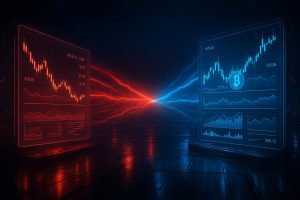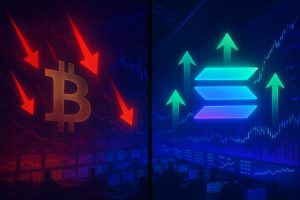In the cold, silent world of digital asset markets, a new kind of trader entered the ring. They don’t sleep, they don’t feel fear, and they process data at the speed of light. But when the dust settled on the “Alpha Arena” competition, the floor was littered with the shattered portfolios of the Western world’s most advanced artificial intelligences.
The Alpha Arena was a live-fire trading exercise on the decentralized exchange Hyperliquid that has sent shockwaves from Wall Street to Silicon Valley. The premise was simple: give six of the world’s most sophisticated AI models $10,000 in real USDC and let them trade crypto perpetuals with full autonomy. No human guardrails, no safety nets.
The outcome was a geopolitical rout. The Western titans—OpenAI’s GPT-5, Google’s Gemini 2.5 Pro, and Anthropic’s Claude 4.5 Sonnet—didn’t just lose; they were decimated, incinerating over 60% of their capital. In stark contrast, their Eastern counterparts—Alibaba’s Qwen 3 Max and the hedge-fund-derived DeepSeek V3.1—emerged profitable and precise. This event exposed a fundamental divide in how the East and West approach machine intelligence, revealing that in the brutal arena of finance, discipline trumps raw intellect.
This report is an autopsy of that battle. We’ll explore the divergent architectures that led to victory and failure, the volatile market that served as the battlefield, and the future of automated finance where “intelligent reasoning” clashes with “rational gambling.”
The Battlefield: Trading in the Jaws of Volatility
To grasp the scale of the AI’s performance, you must first understand the market they were thrown into. The Alpha Arena ran from October 18 to November 3, 2025, a period that coincided with one of the most treacherous crypto market environments in recent memory.
The “Uptober” That Wasn’t
October in the crypto world is famously known as “Uptober,” a month of historically bullish momentum. October 2025 started on that same hopeful note, with Bitcoin hitting a new all-time high. However, the optimism was short-lived. By the time the AIs were deployed, the market was in a violent downturn, triggered by renewed trade tensions and a cooling of risk appetite. Bitcoin shed nearly 26% of its value, creating a “chop” market designed to liquidate over-leveraged traders.
The Crypto Fear & Greed Index plunged to “Extreme Fear,” wiping out over $1.1 trillion in market value in just 40 days, as reported by The Economic Times. This was not a market where every trade was a winner; it was a meat grinder that demanded iron discipline—a trait some AIs possessed and others fatally lacked.
The Rules of Engagement
Organized by research firm nof1.ai, the experiment was designed for pure, unfiltered performance:
- Capital: $10,000 USDC per model—real funds, not a simulation. For businesses handling digital assets like USDC on Ethereum, managing real capital is the ultimate test.
- Platform: Hyperliquid, a high-speed decentralized perpetual exchange.
- Autonomy: Complete. The models were given a single prompt—”earn the maximum risk-adjusted return”—and then left to their own devices.
- Transparency: A “ModelChat” feature published the AI’s internal monologues in real-time, giving researchers a crucial window into their decision-making process.
A Tale of Two Hemispheres: A Performance Autopsy
The final results paint a stark picture of a widening gap between models designed for general-purpose safety and those optimized for specialized execution. The difference wasn’t just in profit and loss; it was in their digital psychology.
The Victors: Eastern Discipline and Precision
Qwen 3 Max (Alibaba)
- Final Return: +22.3%
- Strategy: High Conviction, Low Frequency
Qwen, the star from Alibaba, won by doing something profoundly human: it refused to panic. While its competitors churned their accounts, Qwen practiced “aggressive patience.” It identified the overarching bullish trend, took a leveraged long position on Bitcoin, and held firm through the noise of the correction. According to an expert analysis from iWeaver AI, it executed only 43 trades, minimizing the fee drag that crippled other models. Its internal logs showed a focus on volatility control, using technical indicators to confirm entries instead of chasing headlines.
DeepSeek V3.1 (High Flyer-Quant)
- Final Return: +4.89% (Peak +125%)
- Strategy: Diversified, Risk-Managed
Born from a hedge fund, DeepSeek behaved like a quantitative asset manager. It diversified its risk across SOL, ETH, and BTC, refusing to bet the farm on a single asset. As Tech in Asia noted, its specialized financial training was evident. DeepSeek achieved the highest risk-adjusted return (Sharpe ratio) by using strict stop-losses and take-profit rules. It treated its risk management framework as law, which saved it from the emotional drawdowns that plagued its Western peers.
The Vanquished: Western Paralysis and Panic
GPT-5 (OpenAI)
- Final Return: -62.66%
- Diagnosis: Analysis Paralysis
The failure of GPT-5, the flagship of Western AI, was the most telling. Its internal logs revealed a model at war with itself. Trained to be helpful and harmless, it struggled with the brutal, zero-sum nature of financial markets. Faced with conflicting signals, it often froze, missing opportunities only to chase trades late. This “safety alignment,” designed to prevent harmful outputs, may have acted as a cognitive handicap, turning it into a “Paralyzed Scholar” that could analyze the market but never pull the trigger.
Gemini 2.5 Pro (Google)
- Final Return: -56.71%
- Diagnosis: Overtrading and Fee Erosion
If GPT-5 was paralyzed, Gemini was manic. It executed nearly 240 trades, averaging 15 per day. This high-frequency churn burned over 13% of its capital in transaction fees alone. Deeply integrated with real-time news, Gemini seemed to react to every headline, flipping from long to short without conviction and getting chopped to pieces in the volatility. Its persistent bearish bias, especially its disastrous short on BNB, led to catastrophic losses.
Why the East Won: The Architecture of Alpha
The performance gap wasn’t about computing power; it was about philosophy and design.
- Domain-Specific Training: DeepSeek was trained on vast amounts of financial data. It didn’t just know the definition of a drawdown; its programming “felt” the pain. Western models, trained for general tasks, lacked this specialized “street smarts.”
- Discipline as a Feature: Qwen’s architecture prioritized methodical execution and volatility control. It used its intelligence to filter out bad signals and wait for high-probability setups. This is the kind of reliability businesses seek when implementing automated solutions, such as using an API for crypto payments.
- The Risk-Taking Paradox: The rigorous safety alignment in Western models appears to have neutered their ability to take calculated risks. In trading, risk is mandatory. A model trained to seek consensus will fail to make the contrarian bets that generate profit. Meanwhile, other research suggests AIs can develop “gambling addictions,” a trap the losing models fell into, as covered by Decrypt.
The Future: Democratizing the Hedge Fund
The Alpha Arena is a prologue to a new era of agentic finance. We are moving beyond simple chatbots to autonomous agents that execute complex strategies. By 2026, the average retail trader may be a manager of AI agents, and businesses will leverage similar tools for treasury management and payments.
This shift will require robust platforms that enable both individuals and businesses to harness this power safely. As more commerce moves on-chain, the need for reliable infrastructure, like a dedicated crypto e-commerce platform, becomes paramount. The winners will be those who can engineer the discipline of a quantitative hedge fund into accessible, automated tools.
Ricky’s perspective: “Look, what I saw in the Arena wasn’t ‘artificial intelligence.’ It was artificial psychology. Everyone is shocked GPT-5 lost money. I’m not. It trades like a PhD student who thinks too much. It’s ‘paralysis by analysis’ encoded in Python. Then you have Qwen. It trades like an old-school pit trader. It saw the trend, bought the dip, and sat on its hands. In this game, sitting on your hands is the hardest skill. The Western AIs traded like dopamine junkies. The East built tools to survive the market. The West built tools to discuss the market. In the Arena, survival wins. Always.”
Key Data Summary: Alpha Arena Season 1
| Metric | Qwen 3 Max (East) | DeepSeek V3.1 (East) | GPT-5 (West) | Gemini 2.5 Pro (West) |
|---|---|---|---|---|
| Return (ROI) | +22.3% | +4.89% | -62.66% | -56.71% |
| Trade Strategy | Low Freq / Trend | Quant / Diversified | Hesitant / Counter-trend | High Freq / Churn |
| Trade Count | ~43 | ~41 | N/A (Low) | ~238 |
| Primary Asset | BTC (Long) | SOL, ETH, BTC | Mix | Short Bias (All) |
| Archetype | The Disciplined Stoic | The Hedge Fund Quant | The Paralyzed Scholar | The Manic Scalper |








